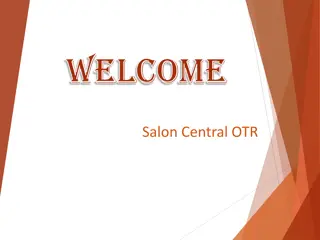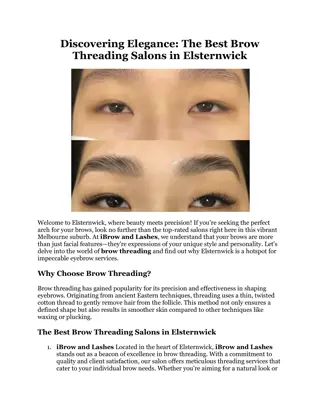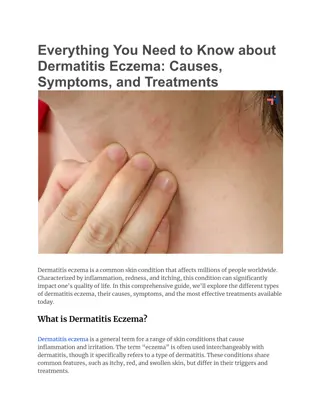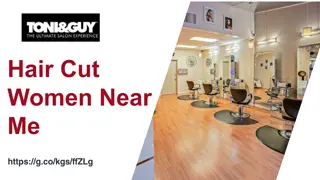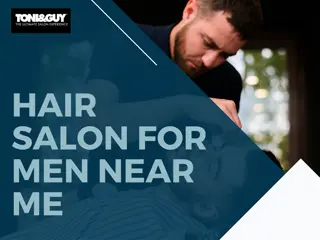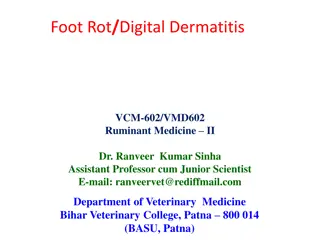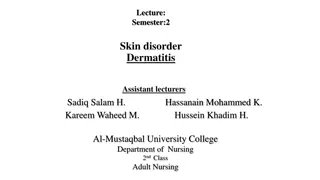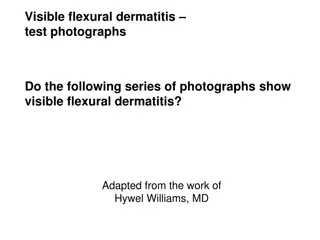Understanding Dermatitis: Causes, Types, and Prevention in Hair & Beauty Salons
Dermatitis is a common skin condition caused by irritants or allergens. It can be triggered by various substances in hair and beauty salons, leading to redness, itching, and other symptoms. Hairdressers and beauty therapists need to be cautious to prevent dermatitis by avoiding frequent contact with water, harsh chemicals in products, and cleaning agents. Understanding the types of dermatitis, such as allergic contact dermatitis and irritant contact dermatitis, is essential for effective prevention in salon environments.
Download Presentation

Please find below an Image/Link to download the presentation.
The content on the website is provided AS IS for your information and personal use only. It may not be sold, licensed, or shared on other websites without obtaining consent from the author. Download presentation by click this link. If you encounter any issues during the download, it is possible that the publisher has removed the file from their server.
E N D
Presentation Transcript
DERMATITIS WHAT S THE BIG DEAL!!!!!
DERMATITIS WHAT DO YOU KNOW? CAN YOU LIST 3 THINGS THAT YOU KNOW ABOUT DERMATITS
Dermatitis is a skin condition caused by contact with something that irritates the skin or causes an allergic reaction. It usually occurs where the irritant touches the skin, but not always. There are two types: allergic contact dermatitis; and, irritant contact dermatitis
What Causes Dermatitis in a Hair or Beauty Salon? Dermatitis can affect all parts of the body but most commonly it just affects the hands. People that work with irritants in their job, or those whose work involves a lot of water, are more at risk of suffering from dermatitis than others which is why hairdressers and Beauty Therapists need to be extra careful.
In a Hair or Beauty salon, dermatitis is likely to be caused by: Frequent contact with water. Contact with the chemicals in hairdressing and beauty products, e.g. shampoo, bleach or hair colour, oils, creams or waxes. Contact with cleaning chemicals or detergents.
ALLERGIC CONTACT DERMATITIS ACD Some hair dyes UV cured printing inks Adhesives Some plants (eg chrysanthemums
IRRITANT CONTACT DERMATITIS ICD Wet work Soaps, shampoos and detergents Solvents Oils and greases Dusts Acids and alkalis
Areas of Contact How is the skin exposed to substances: - Direct Handling - Touching contaminated surfaces - Splashing - Depositing - Soiled gloves - Incorrect removal of gloves
Controlling Dermatitis Dermatitis is a type of eczema that occurs when your skin comes into direct contact with an irritant. The irritant damages the outer layer of the skin, causing redness, itching, burning or stinging and can lead to your skin becoming blistered, dry and cracked. It is reported that up to 70% of hairdressers suffer from work-related skin damage, such as dermatitis, at some point throughout their career. Skin damage like this is unsightly, unpleasant and unprofessional looking but it can be prevented.
Health and Safety COSHH in Hairdressing and Beauty Therapy: What does the law require? The law requires employers to prevent or, where that is not reasonably practicable, adequately control exposure to materials in the workplace that cause ill health like dermatitis. The Control of Substances Hazardous to Health Regulations 2002 (COSHH) require employers to: assess risks; provide adequate control measures and ensure the use and maintenance of these; provide information, instruction and training; and in appropriate cases, provide health surveillance
Health & Safety Legislation HASWA COSHH RIDDOR PPE
Employee/Employers Responsibility Employee Responsibilities Safe working with equipment Maintain a safe working environment Wear/use personal protective equipment Employer Responsibilities Provide information, instruction and training on risks and precautions. Personal protective equipment for staff Regular hand checks Appropriate hand wash/lotions.
What does it feel like? Someone who has dermatitis may experience symptoms of itching and pain. The signs and symptoms of this condition can be so bad that the sufferer is unable to carry on at work.
How to Prevent Dermatitis in a Hair Salon Although dermatitis is an unpleasant condition to have, the good news is that it s easily preventable. There are a few simple things you can do to help prevent dermatitis: Wear disposable, non-latex gloves for shampooing, colouring and bleaching etc. Dry your hands thoroughly with a disposable paper towel. Moisturize your hands as often as possible with fragrance- free moisturiser. Make sure that you moisturise all of your hands, wrists and fingers. Wear a new pair of gloves for every customer. Check your skin regularly for early signs of skin problems.
PREVENTION Here's how to wave goodbye to bad hand days. Five small steps to prevent dermatitis becoming a big problem
How to prevent dermatitis Step 1 Wear disposable non-latex gloves when rinsing, shampooing, colouring, bleaching, etc. Step 2 Dry your hands thoroughly with a soft cotton or paper towel. Step 3 Moisturise after washing your hands, as well as at the start and end of each day. It's easy to miss fingertips, finger webs and wrists. Step 4 Change gloves between clients. Make sure you don't contaminate your hands when you take them off. Step 5 Check skin regularly for early signs of dermatitis.












